Shooting on KODAK DP Linus Sandgren FSF ASC delivers cinematic style to Noah Baumbach's 'Jay Kelly'
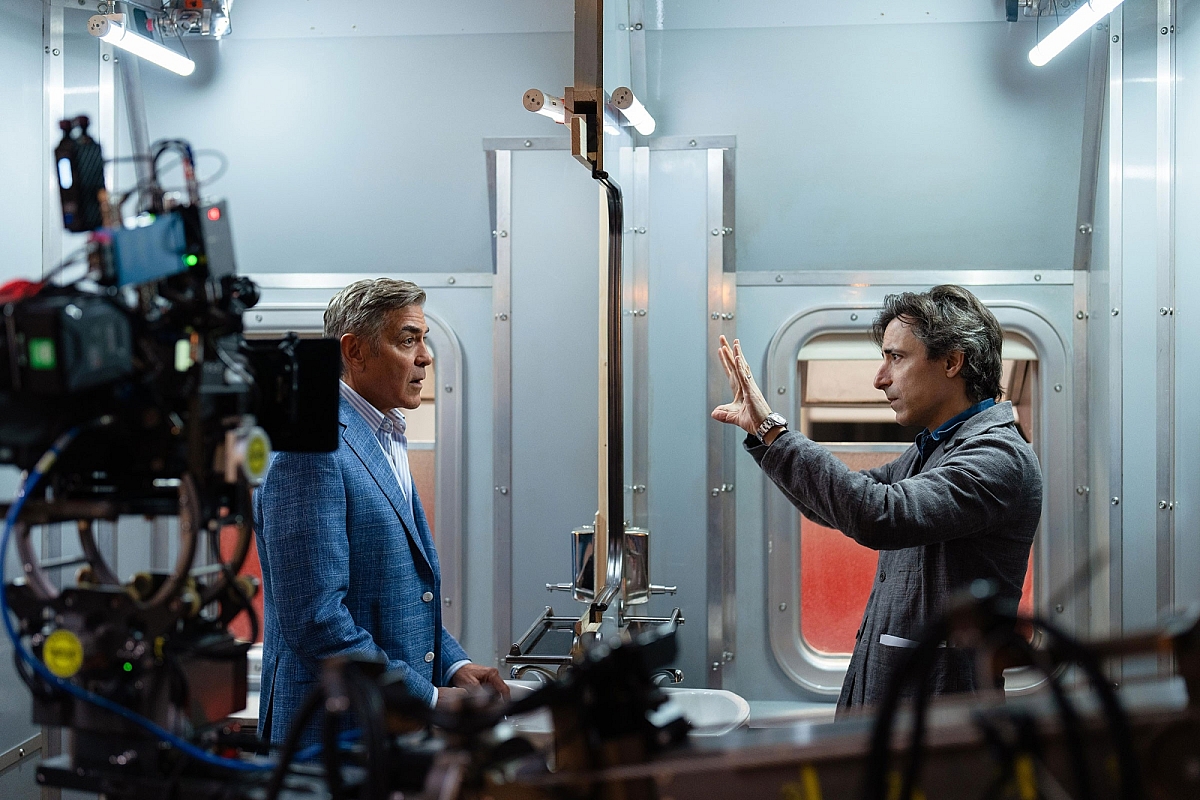
(L-R) George Clooney as Jay Kelly and director Noah Baumbach on the set of JAY KELLY. Photo by Peter Mountain/Netflix © 2025.
If you wanted to bring a theatrical flourish to your picture, especially one with a story about the movies and stardom, and to shoot it on 35mm film too, then who better to hire than someone steeped in the art of doing just that?
That's what happened when director Noah Baumbach lured Oscar-winning DP Linus Sandgren FSF ASC for the star-studded Netflix production Jay Kelly, about a megawatt motion picture idol and his devoted manager, who embark on an unexpectedly profound journey through Europe and find themselves confronting the choices they've made, the relationships with their loved ones, and the legacies they'll leave behind.
Sandgren counts Damien Chazelle's La La Land (2016) and Babylon (2022) amongst his canon of more theatrically-styled projects, not to mention a certain cinematic bravura in films such as First Man (2018, dir. Damien Chazelle), No Time to Die (2021, dir. Cary Joji Fukunaga) and Saltburn (2023), to mention just a few – all of which were shot on KODAK film.

George Clooney as Jay Kelly in JAY KELLY. Photo by Peter Mountain/Netflix © 2025.
Written by Baumbach and Emily Mortimer, Jay Kelly stars an ensemble cast including George Clooney as the icon Jay Kelly and Adam Sandler as Ron his manager, alongside Laura Dern and Billy Crudup. It had its world premiere in the main competition of the 2025 Venice Film Festival, where the cast received glowing reviews for their performances, especially the meta-narrative of Clooney playing a global superstar. Sandgren's cinematography was similarly hailed for its wonderfully rich cinematic language, including several surreal set-piece flashbacks when Jay Kelly walks-in on his own memories.
"In its concept and, as I discovered, during its creation too, this film is all about love," says Sandgren. "Love for the movies and moviemaking, love for other people, the kind of love we ought to have for ourselves, and the love we should leave behind.
"We see Jay Kelly grappling with who he is beyond his on-screen persona, taking a soul-searching journey and reflecting on past mistakes. I related strongly to that. The personal vulnerabilities of dedicating yourself to something, being away from home for long periods, particularly the impact on family and your regret about missing time spent with loved ones, are things we all have to deal with, especially in filmmaking."
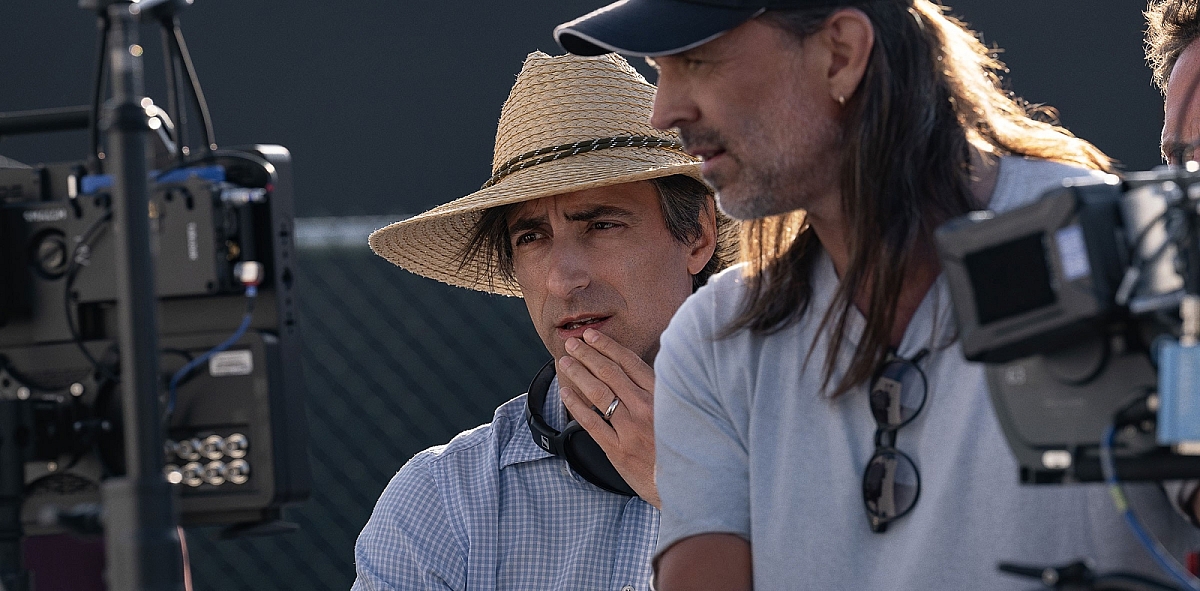
(L-R) Noah Baumbach and Linus Sandgren on the set of JAY KELLY. Photo by Wilson Webb/Netflix © 2025.
Although Sandgren had not worked with Baumbach previously, he reveals himself to be a great admirer of the director's The Squid and the Whale (2005, DP Robert D Yeoman ASC), due to the film's "gritty, naturalistic approach and brilliantly-intimate cinema-vérité feel. I often recommend it when hosting classes about cinematography," says the DP.
"Noah and I struck up an immediate connection and during the course of many long subsequent Zoom calls about the visual storytelling, it became clear to see the passion he had for this project, and the way he envisaged it as a blend of classic movie magic and European cinema. He wanted it to be an ode to all of that.
"In this production, our camera needed to be anchored around and emotionally connected to Jay with him in almost every frame, but be free enough to introduce and include other characters. I was also keen to embrace Noah's challenge of incorporating a surrealist element into the storytelling, such as Jay literally walking into his own memories, to highlight the contradictory themes of artifice and reality."
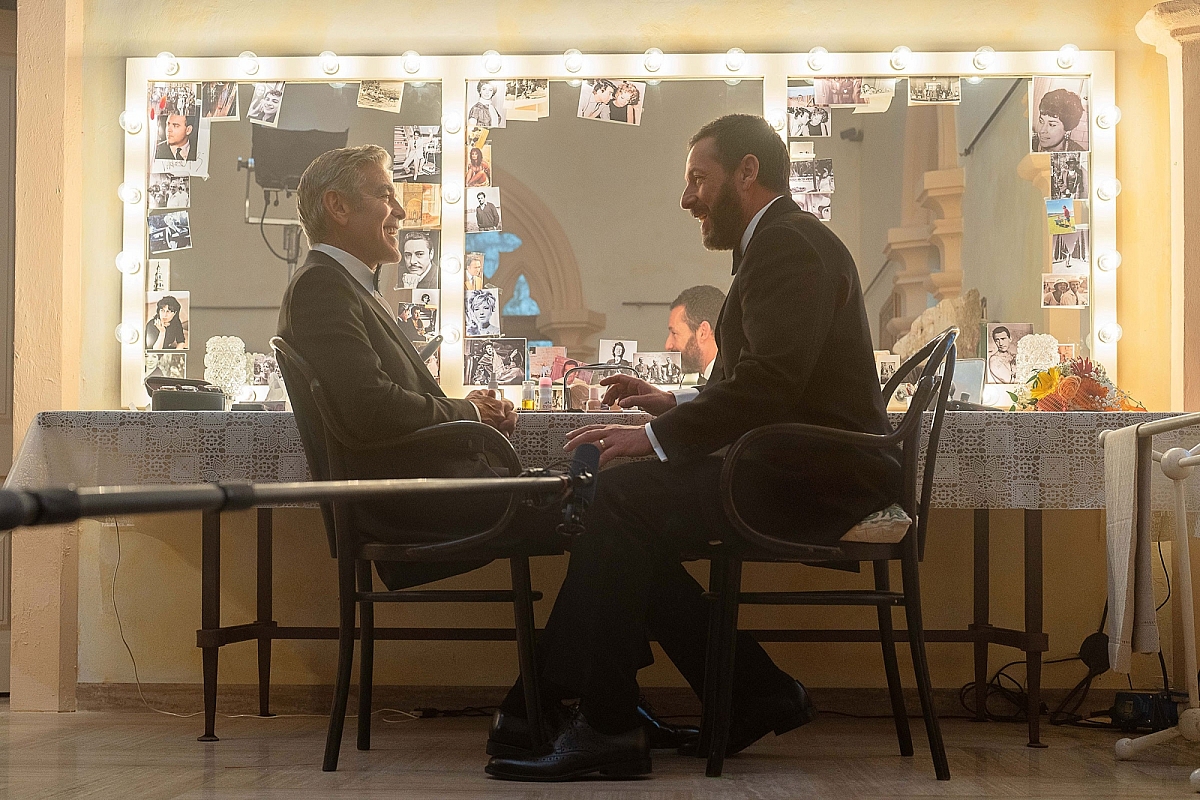
(L-R) George Clooney as Jay Kelly and Adam Sandler as Ron Sukenick on the set of JAY KELLY. Photo by Peter Mountain/Netflix © 2025.
When it came to creative references, Sandgren reveals, "We watched a lot of films that influenced things, for example movies by Federico Fellini starring Marcello Mastroianni, like La Dolce Vita (1960, DP Otello Martelli) and 8½ (1963, DP Gianni Di Venanzo), in which the central characters are in fruitless searches for one thing or another, and where the style blurs so beautifully between fantasy and reality. We also took in movies like Night Train (1959, dir. Jerzy Kawalerowicz, DP Jan Laskowski) for the way the action was captured cinematically through railway carriages."
Like Sandgren, Baumbach is a film stalwart, having previously shot The Squid and the Whale, The Meyerowitz Stories (2017, DP Robbie Ryan BSC ASC), Marriage Story (2019, DP Robbie Ryan BSC ISC) and White Noise (2022, DP Lol Crawley BSC ASC) on 16mm or 35mm film.
"Both Noah and I love shooting on film," Sandgren remarks, "and there was never any question that Jay Kelly was always going to be shot on anything other than 35mm.
"For me, a large part of cinematography is about evoking emotions, and film has texture and depth to it, an imperfection and impressionistic feel, that I really believe helps to do that. It also helps to suspend the disbelief, in an instant.
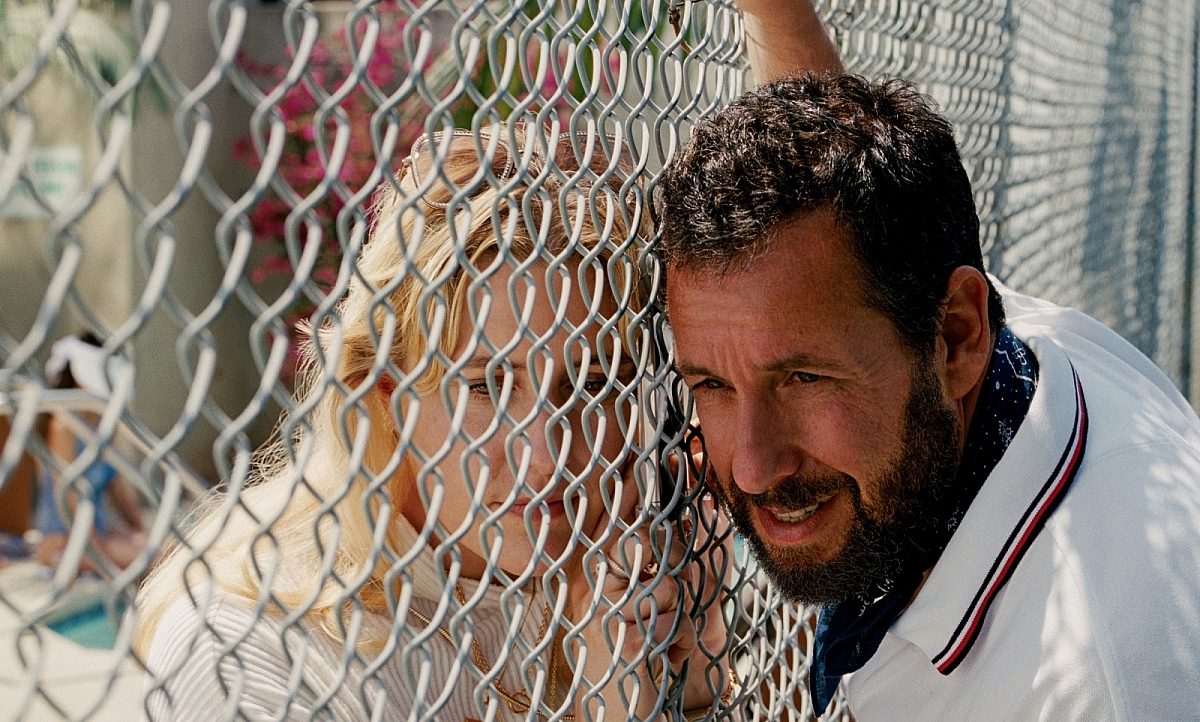
(L-R) Greta Gerwig as Lois Sukenick and Adam Sandler as Ron Sukenick in JAY KELLY. Photo by Netflix © 2025.
"So the main decision we had to make was whether to shoot Jay Kelly in classic Hollywood 2.40:1 Anamorphic, or whether it should be framed in the more traditional European widescreen filmmaking format of 1.66:1 of the '70s and '80s, and the latter is where we eventually landed.
"We both felt that 1.66:1 would be the most honest to the humanity in the story, placing Jay in each environmental, while being a kind of nostalgic homage to European cinema."
Principal photography on Jay Kelly took place across a total of 60 shooting days, beginning in March 2024 with a two-day stint in Tuscany to shoot the background plates for the lengthy section of the movie that takes place on a train.
The interiors of Jay Kelly's Malibu mansion and the interior train scenes were all shot on constructed sets at Shepperton Studios, UK, respectively using traditional backdrops and modern LED walls. The flashback scenes depicting Jay Kelly appearing in his own memories, involved production designer Mark Tildesley constructing dual sets side-by-side, enabling Clooney and the camera to travel as if by magic from an aeroplane into an audition theatre, and from the train to a film set.
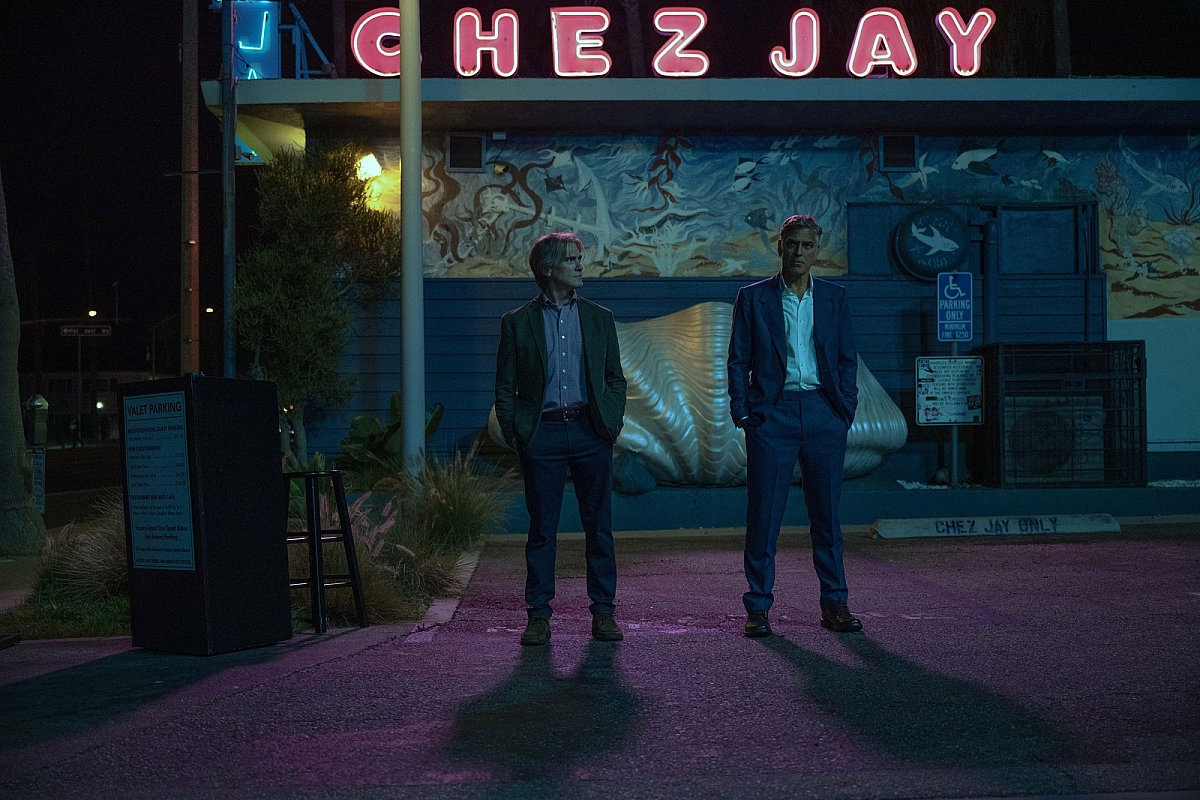
(L-R) Billy Crudup as Timothy and George Clooney as Jay Kelly in Jay Kelly. Photo by Wilson Webb/Netflix © 2025.
Interior and exterior locations nearby Shepperton and London doubled for US-based settings in the story. Filming also took place in Pienza, Tuscany, where a railway station set was constructed.
Sandgren's main camera on the production was a 3-perf 35mm Aaton Penelope, adapted to take Panavision Primo lenses, with the camera package provided by Panavision in London.
"I love the Penelope as it can do everything an ARRICAM LT or a Panavision XL can do, but it's quieter, smaller and more efficient in various ways. For instance, it takes just a few seconds to reload a 400-foot magazine – which meant Noah and the cast could immediately go for another take without having to hang around for us.
"Also, for scenes on the train, where the camera tracks back and forth several times through the crowded carriage, shooting handheld would have been tricky. So were able to create a sense of that by mounting the Penelope and a Camera Revolution Libra Head on a 73-foot Chapman Leonard Hydroscope crane. We turned the Libra Head through 90° to its normal 'Matrix' mode, which switched the tilt and pan around. This meant the camera could swim like a fish between the performers on the crane, with the Penelope being less intrusive for the actors to perform around."

(L-R) Director Noah Baumbach and Director of Photography Linus Sandgren on the set of JAY KELLY. Photo by Wilson Webb/Netflix © 2025.
As for the lenses, Sandgren remarks, "I know the Panavision Primos having used them on The Nutcracker and the Four Realms (2018, dirs. Lasse Halström & Joe Johnson) and Saltburn. I like the luscious, colorful and subtly stylized aesthetics they bring to the picture."
Sandgren shot the movie's day exteriors on KODAK VISION3 5203 50D, with KODAK VISION3 5213 200T for day interiors and KODAK VISION3 5219 500T for low light and night scenes. Regular film processing – without any push or pull-processing – plus 4K scans, were done at Cinelab in the UK, with dailies overseen by Doychin Margoevski and the final grade conducted by Matt Wallach at Company3.
"I always like to scan the negative once and for all in 4K, so that the dailies grade CDLs can move on to the DI. This way I can spend proper time to make sure the film gets the look we want already in the dailies. The final DI is then a collaboration between me, Doychin and Matt, to get where we finally land.

(L-R) George Clooney as Jay Kelly and Riley Keough as Jessica in JAY KELLY. Photo by Peter Mountain/Netflix © 2025.
"I like to always start with a print emulation LUT so that we always can do a print, and then do printer light adjustments first, and then primaries as needed. If we do it right, the dailies should have the look of the final movie, and the DI is primarily a time for finer adjustments."
While Sandgren shot on traditional film, he had no hesitation in using it in combination with the very latest in LED wall and lighting technology for the train journey sequences.
"I remember Haris Zambarloukos BSC GSC using a flat LED wall to such good effect on Murder on the Orient Express (2017, dir. Kenneth Branagh), seeing how the light reflected nicely on glass and wood. This made me choose the same type of LED panels when we built a 60-foot diameter and 40-foot-tall half-cylinder (that later became the volume) for First Man. We had 360° video imagery for various scenes, that we could rotate to camera, and wrap around our sets. The 30-foot distance to the wall gave us a realistic depth-of-field.
"I really find LED walls to be painted backdrops 2.0 and should be used as such. We decided to use this technique for Jay Kelly, which turned out to be really helpful and efficient on set, and radically minimized the post production time as most shots from the LED volume shoot were untouched.

(Featured L-R) Lars Eidinger as German Cyclist, Ferdi Stofmeel as Dutch Cyclist and George Clooney as Jay Kelly in JAY KELLY. Photo by Peter Mountain/Netflix © 2025.
"I have worked with my gaffer David Sinfield ICLS on every film I've shot in England and around Europe, and he is always at the forefront of lighting and what you can do with it. Working with our lighting supplier MBS, he helped to devise a lighting setup in the LED volume that gave exactly the lighting effects I was looking for."
Background plates for the train journey were shot in 8K on Sony Venice 2, using a super-wide Entaniya Hal 220° fisheye lens several months before principal photography began in order to get them prepared and running properly on the LED wall set at Shepperton Studios.
Sandgren remarks, "When we shot the plates for our train sequences, it was incredible to see how real sunlight moves around in a train, how it flickers because of trees or posts passing by, how it bounces up from the adjacent train tracks onto the ceiling, or reduces to nothing in a tunnel, and this influenced how we designed the LED wall and the lighting.
Using Roe Black Pearl 2 2.8 mm pixel-pitch panels, two LED walls, measuring 7 m tall and 30 m wide, were built along each side of the train carriage, around 5 m away, with the ends of each wall angled to wrap around the front and rear of the carriage and help give correct parallax during filming.
As the idea was that one side of the carriage would face the sun, each window looking that way had illumination from nine dedicated Nanlux Evoke 2400B fixtures, controlled by DMX. The Evokes were fitted on sliding trusses, which could be moved back and forth to create a sense of motion. MBS Aquabat LED battens were also fitted to the top and bottom of each window to help provide moving reflections and support a three-dimensional quality to the lighting.

George Clooney as Jay Kelly in JAY KELLY. Photo by Peter Mountain/Netflix © 2025.
Inside the train, LED practical could be flickered on or off as necessary, and ARRI Sky Panels diffused through Magic Cloth were used to provide ambient light coming though the train's skylights.
"You don't really see the background plates, rather the scenery whooshes by, and the genius of using LED walls is the way you can use them for interactive lighting," Sandgren enthuses.
"We wanted our train sequences to look as authentic as possible, and the setup was designed to give Noah and I the capability to play with the lighting according to the emotions in each scene.
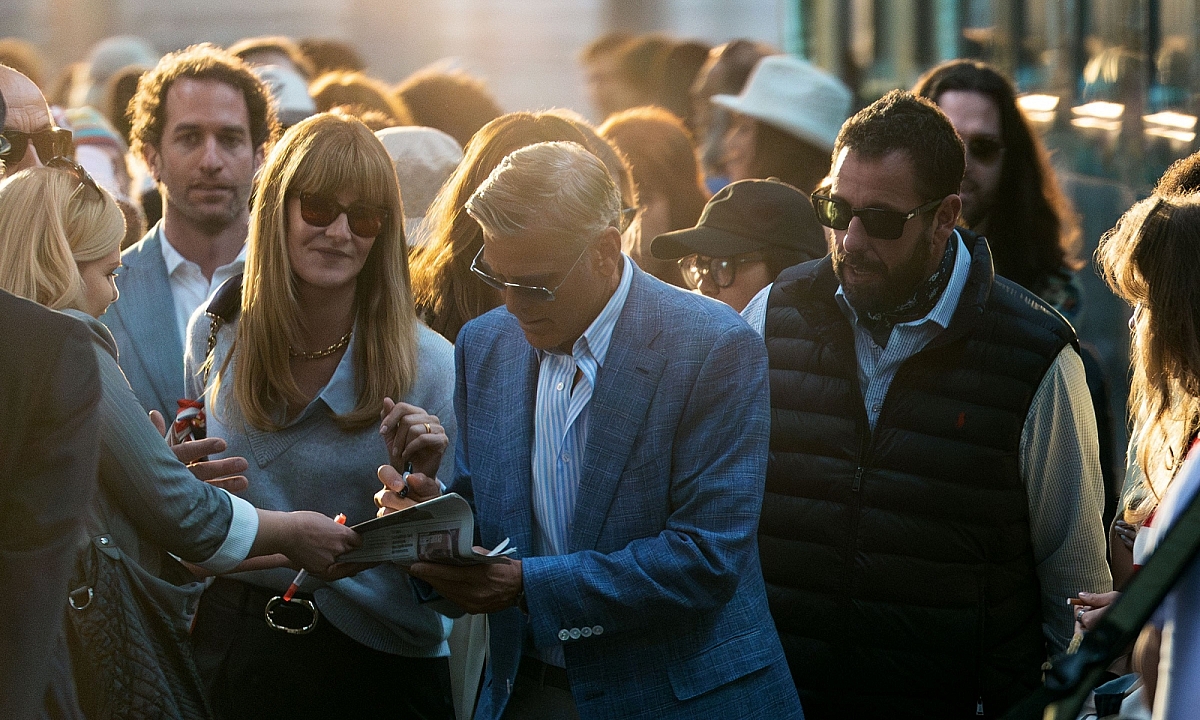
(Featured L-R) Laura Dern as Liz, George Clooney as Jay Kelly and Adam Sandler as Ron Sukenick in JAY KELLY. Photo by Peter Mountain/Netflix © 2025.
"At any one point Adam Baker, our lighting programmer, could trigger different parts of the background plate, to give us uninterrupted golden sunlight, a couple trees flashing by, the shadows from a steel bridge, or the dramatic darkness of a tunnel, and could also change the color and intensity of the lighting as appropriate to the moment, all at the press of a button. It was quite brilliant."
Along with the LED wall, Sandgren also employed Rosso SoftDrop translights to create the day and night background vistas from Jay Kelly's Malibu home, which was actually built as a two-story set at Shepperton, using a Softsun 100K to create the effect of bright sunlight.
"I really loved working with the SoftDrops, as we could light the fronts in tandem with the Softsun for day scenes or just the backs for night times. We could easily elevate or reposition them depending on which floor the action was taking place for the correct horizon line, and the results were insanely good."
Sandgren concludes, "This story was personal to me, and I am sure it will resonate with many who see it. It was amazing to work with Noah. He's a brilliant storyteller, and I found it very rewarding to have all those long discussions with him and get to know him before we started production. We got really close making this film, and the final result is the way he originally intended it to be – a story that slowly boils away with emotions, and an ode to cinema."